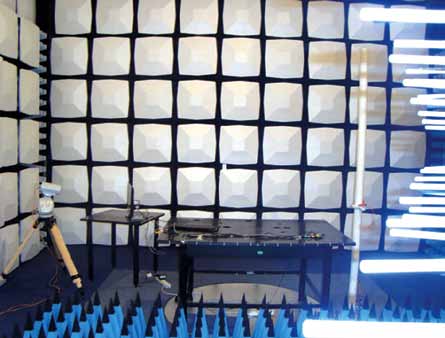
Radiative immunity test. The Raspberry Pi is at the front right corner of the table. The video camera at the left is for monitoring output while the test is run
Electronics has its hazards in the form of electric shock, toxic fumes from components, fire due to short circuits, etc. Ideally, every component and equipment should be designed such that it poses no danger to its users. Various national or international standards are framed keeping in view the working environment and usage of the product. For every product, there are certain requirements to be met in order to ensure the safety of the users.
A background on international certifications
Every consumer electronics device that is commercially available in the global market has a certain mark on its back or side, such as CE or CCC, which shows the certification that it adheres to. Every country has a technical barrier, which is bureaucratically controlled to protect the local market or local imports. In India, we have the Bureau of Indian Standards (BIS) that sets the standards for the Indian region.
Kalyan Varma, head-India, TUV Rheinland, explains: “If you make a product that meets the entire Indian requirements, considering all the environmental conditions that we have in India starting from Kashmir to Kanyakumari, along with the BIS requirements, it would be a better product than what we get with the CE mark of Europe.”
[stextbox id=”info”]
While we do the design, we need other electronic components which we don’t produce by ourselves. We need to make sure that these components, which were bought from other suppliers, are also CE- and RoHS-certified. Otherwise, the whole designed part would not be allowed in the CE market
— Yu Yinsheng, general manager, Foryard Optoelectronics
[/stextbox]The reason is the varying conditions in India. A power supply manufacturer in India, while designing a power supply, will definitely consider power outages, voltage fluctuations or surges, which are common in India. “This is usually not the case when these products are designed in the US or elsewhere,” adds Varma.
Designing compliant products is challenging
Compliance testing assesses the electromagnetic compatibility (EMC) of the device and the electromagnetic noise generated by it. EMC testing ensures that products that have passed this test don’t cause interference to other products of the consumers and also don’t get affected by them.
Liz Upton from the Raspberry Pi Foundation explains how the Raspberry Pi got through CE, FCC regulation and C-Tick requirements: “The Raspberry Pi had to pass radiated and conducted emission and immunity tests in a variety of configurations (a single run can take hours), and was subjected to electrostatic discharge (ESD) testing to establish its robustness.”
[stextbox id=”info” caption=”Some Indian regulators”]Those looking for access to the Indian market should get their products certified for the Indian market by the following regulatory bodies as applicable:
• Standardization Testing and Quality Certification (STQC) Directorate
• Bureau of Indian Standards (BIS)
• Telecommunication Engineering Centre (TEC)
• Wireless Products Certification Wing (WPC)
• Central Drug Standard Control Organisation (CDSCO)
• Automotive Research Association of India (ARAI)
• Bureau of Energy Efficiency (BEE)[/stextbox]
[stextbox id=”info” caption=”International certifications”]Given below are some of the certifications that are mandatory for marketing your products in various international markets:
CE. It stands for ‘Conformité Européenne’ and is mandatory for products targeted at the European Economic Area. It is a declaration by the manufacturer that the product conforms to the EC directives.
FCC. Short for ‘Federal Communications Commission,’ it works towards six goals in the areas of broadband, competition, spectrum, media, public safety and homeland security. The FCC regulations are meant for the US market.
C-Tick. The C-Tick mark is intended for use on products that comply with EMC standards. It indicates that the product complies with the applicable standard and establishes a traceable link between the product and the supplier responsible for placing it on the Australian or New Zealand market.
CCC. It stands for ‘China Compulsory Certificate,’ and is mandatory for products targeted at the Chinese market. It is said to be one of the most difficult certifications, not because of the technical requirements but the difficulties related to the language of documents and compulsory on-site testing of manufacturing.
IEC 60950. This is an electrical safety requirement standard for IT and telecom products like laptops and phones. In India, this standard is known as the IS 13252 by the Bureau of Indian Standards.[/stextbox]








